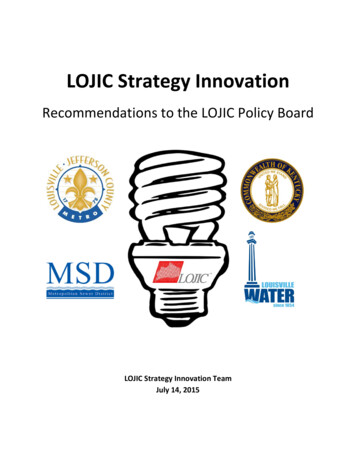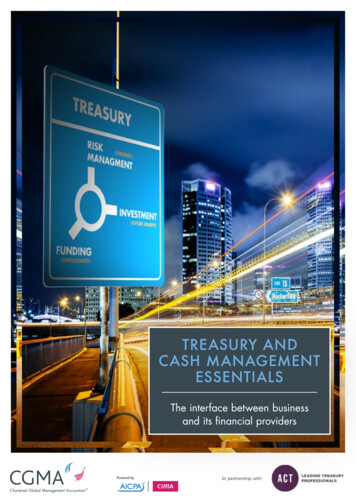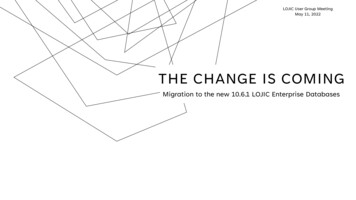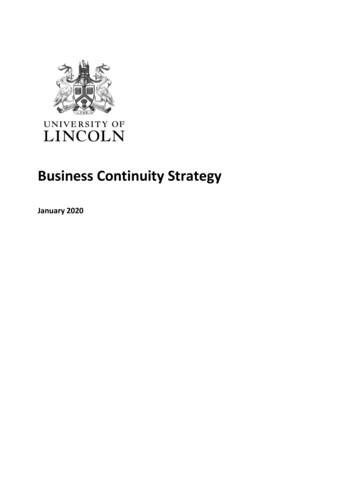
Transcription
LOJIC Strategy InnovationRecommendations to the LOJIC Policy BoardLOJIC Strategy Innovation TeamJuly 14, 2015
LOJIC STRATEGY AND INNOVATIONJuly 2015This report, LOJIC Strategy and Innovation, is provided to the LOJIC Policy Board as the final deliverableof the LOJIC Strategy Innovation (SI) effort. Per the guidelines and goals set forth in the organizingcharter, the SI team spent 15 months conducting an exhaustive analysis of the current status of, andfuture opportunities for, LOJIC with consideration given to governance, funding, technology andoutreach. As the LOJIC SI Team progressed on its mission, it encountered many questions and gaps thatshould be addressed in order to assure the viability of the consortium. Some of the questions and gapswere those initially identified by the LOJIC Policy Board as a reason for chartering the team, while otherswere revealed as the team conducted the Discovery Phase of the SI process. Based on these inputs, thefollowing questions served as the SI Team’s focus for the Creating Phase, as well as an outline for thefinal recommendations to the LOJIC Policy Board included in this report:1) What is the ideal/recommended governance structure for LOJIC?2) In what ways can LOJIC or its individual partners either generate revenue or offset the costs ofoperating LOJIC?3) On what should the percentage cost responsibilities for the LOJIC partners be based, and howmuch should that be for each partner?4) What applications can/should LOJIC develop that will have the greatest impact on and benefitfor the user community?5) What changes, if any, could/should be made to LOJIC’s system architecture and data storagestrategies that will optimally position the consortium in today’s IT environment?6) What steps can LOJIC take to strengthen, advertise and/or remake its brand and promoteawareness of how to use it?7) How will “Open Data” concepts and initiatives impact LOJIC mission and operations?This report contains references to four documents prepared and submitted by Croswell-Schulte ITConsultants (CS) as a part of the LOJIC Strategy Innovation effort. The reports are cited as tus of LOJIC Operations and User CommunityReport on National Survey of Multi-Organizational GIS ProgramsBest Innovative Practices Profile ReportRecommendations of LOJIC Governance, Funding and OperationalImprovementsDATEFeb 5, 2015Feb, 2015Feb 5, 2015Mar 31, 2015The recommendations contained herein represent the distillation of considerable research and analysisconducted by both the LOJIC SI Team and Croswell-Schulte IT Consultants.1
1) What is the ideal/recommended governance structure for LOJIC?BACKGROUNDOriginal LOJIC partner lease/purchase agreements executed in 1988 between MSD (55% share), formerCity of Louisville (20% share), Jefferson County (20% share) and PVA (5% share) defined partner “buyin”, governance, partner roles and responsibilities. Louisville Water Company joined LOJIC in 1996 underterms as an immediate equity owner (20% share) of the system, thereby reducing MSD’sownership/funding level (to 35% share). These agreements expired in 2003, two years after City/Countymerger. Following Metro merger and reassembly of the LOJIC Policy Committee, members committed tomaintaining existing governance structure and funding levels to keep LOJIC healthy and growing. At thattime Metro simply assumed the combined 40% funding shares from the former City and County.Members also committed to completing a LOJIC strategic plan and to sustaining the partnership viaMOU during the interim as well as working toward a renewed partnership agreement.PLANNING AND VISIONINGIn 2006-2007 LOJIC and Esri conducted multi-day “GIS Visioning” workshops with partner managers. TheConsortium conducted internal user surveys and developed statements of LOJIC mission, values, andvision. During that time the Policy Committee and staff also developed a LOJIC Strategic Plan to guidethe partnership and further development of LOJIC for the following 3-5 years. An interim MOU crafted in2006 was reviewed and approved by the Policy Committee and all partner legal counsel; however, thisdocument was never officially fully executed by Louisville Metro. The Consortium has been operatingwithout a formal agreement ever since. The aforementioned documents can be viewed through thefollowing links:Visioning SummaryUser SurveysLOJIC Mission, Values and VisionLOJIC Strategic ww.lojic.org/main/about/pdfs/LOJIC Strategic Plan 2007.pdfCURRENT ASSESSMENTA majority of Best Practices Survey respondents, notably those GIS partnerships of a size, scope, budgetand duration comparable to LOJIC (e.g., MCAMLIS, PAGIS, SANGIS, METRO, CAGIS, KGIS, AIMS andothers) maintain formal written agreements to define governance, partner roles, funding terms,relationships, responsibilities and ongoing mutual commitments. While most of these GIS partnershipsprovide limited levels of GIS products and support to ancillary entities such as small cities, neighborhoodgroups and academia, none are a significant source of revenue nor carry any governance or budgetaryresponsibility within the partnerships. The predominant form of GIS partnership consists of a limitednumber of major entities (city/county governments, local agencies and utilities) bound together viawritten agreement with shared responsibility for governing, funding and maintaining a GIS enterprise.The need for a formal partnership agreement is echoed in the GIS Capability Maturity Model (CMM)Assessment performed for LOJIC by the Croswell-Schulte team and included in the Status of LOJICOperations and User Community (CS-OUC) report. The CMM for LOJIC cites the need for, “active writtenagreements among partner organizations” as well as “improved and better defined role of Policy Board”as important enabling factors for LOJIC’s continued success.2
User surveys and internal focus group discussions indicated a decline in direct interaction andcollaboration with LOJIC staff, inactive technical committee and user groups attributable to the lack offormal commitment and shared funding among LOJIC partners. For 25 years LOJIC has endeavored to beviewed as extensions of partner staff. The post-2010 change in LOJIC funding in which MSD has carriednearly all operations expenses except for the ELA has caused reluctance among users to seek LOJIC staffassistance with new GIS projects and uses and reluctance among LOJIC staff to perform outreach tousers.RECOMMENDATION #1:RENEW FORMAL PARTNERSHIP AGREEMENTThe SI team strongly recommends that LOJIC partner commitments be codified and formalized througha written inter-local agreement that defines governance, structure, roles, funding and mutualresponsibilities. The agreement should name a managing partner agency with defined roles,responsibilities and appropriate cost sharing as necessary to provide office facilities, IT, humanresources, procurement, financial and legal support for LOJIC. Over the years LOJIC participants havebenefitted from having a single agency serve as managing partner and this business model shouldcontinue. A new agreement that covers the above provisions will stabilize the partnership, foster userconfidence and ensure the future of LOJIC as a healthy, viable organization and shared resource. Theunexecuted MOU from 2006 (Appendix 1) should serve as the ideal starting point.RECOMMENDATION #2:CLARIFY ORGANIZATIONAL STRUCTURE AND ROLESLOJIC’s longstanding governance and organizational structure consisting of a Policy Board, ManagingPartner Agency, Steering (formerly Technical) Committee, LOJIC Manager and LOJIC staff has workedreasonably well over the years, but should be endorsed, revitalized and empowered via partneragreement with specific roles and responsibilities and to better respond to current needs. Key elementsof LOJIC organizational structure are described below and further categorized in the matrix “LOJICOperational Functions and Responsibilities” that follows.LOJIC Policy BoardThe LOJIC Policy Board should serve as the collaborative oversight body for LOJIC with authority onbudgetary and policy matters for the consortium and should consist of the chief executive of eachpartner agency along with the LOJIC Manager. Policy Board members should be actively engaged asleaders and advocates for the effective use of LOJIC within their respective agencies and across thecommunity. The Policy Board should meet at least quarterly with minimum expectation of a statusreport from the LOJIC Manager. The Policy Board should have review/approval authority for annualwork plans and budgets, enterprise software licensing, partnership expansion and data/product policies,licenses and fees based on recommendations and input from the Steering Committee. Specificprocedures for Policy Board approval of items of business must be defined.LOJIC Steering CommitteeA LOJIC Steering (formerly Technical) Committee, consisting of GIS leadership from partner agencies andkey LOJIC staff, should be established and charged with the strategic direction of LOJIC. The SteeringCommittee should be empowered to plan and prioritize needs and solutions with appropriate decisionmaking procedures. The Steering Committee should be expected to represent individual partnerpriorities and be directly involved in developing annual work plans for recommendation to the PolicyBoard and serve as the collaborative body for resolving technical and resource issues for LOJIC.3
LOJIC ManagerThe LOJIC Manager will provide oversight and direction to LOJIC operations, prepare and manageoperational and capital budgets, strategic plans, operating procedures, negotiate contracts, administerGIS software licenses and Esri resources, and coordinate collaborations with user agencies. The LOJICManager will direct the day-to-day projects and activities of LOJIC technical staff in providing core GISdatabase management, applications development, user support, training and outreach. The LOJICManager should serve on the Steering Committee and serve and its liaison on the Policy Board topresent recommendations, budget proposals, and report on resource needs, project status and useractivities. LOJIC technical staff operates best when seen as extensions of partner agency staff to supportdata, applications, analysis, products and support needs of all users. Historically, this means of operationhas resulted in a wide range of mission-critical uses of LOJIC from custom applications for dailymaintenance of properties, street centerlines and addresses, Hansen/HARP viewers to ad hoc analysisand mapping for emergency response. Partners should take whatever steps are necessary via newpartnership agreements, more equitably shared funding of operational expenses and othercommitments to foster closer collaborations between LOJIC staff and users.LOJIC Operational Functions and ible GroupManagingSteeringLOJICPartnerCommittee dminister/ReportSW / Manage ELASLA LicensingNegotiate/Draft sDevelopReviewApproveAdminister/Implement/Report4
LOJIC Operational Functions and Responsibilities (Cont.)FunctionSub-TaskPolicyBoardResponsible GroupManagingSteeringLOJICPartnerCommittee nAdministerHouseMonitorPlanningStrategic Business PlanDevelop WorkplanImplement WorkplanResource AllocationsProject ManagementSuccessionStaffingIdentify / Justify tionsSuccession PlanningOutreach /MarketingIdentify OpportunitiesExpand / Refine BrandApproveSet / Establish GoalsIdentify Training NeedsImplement TrainingCoordinate CommunicationManage Feedback fromStakeholders2) In what ways can LOJIC or its individual partners either generate revenue oroffset the costs of operating LOJIC?In its investigation of potential revenue sources and cost offsetting measures, the LOJIC SI Team utilizedthe Best Innovative Practices Profile Report (CS-BIPPR) assembled by Croswell-Schulte IT Consultants aswell as input solicited through interviews with experts associated with various aspects of the GISindustry. The research survey conducted by Croswell-Schulte obtained feedback from 38 municipal andstate GIS organizations across the United States and Canada. The team gave consideration to data salesas a revenue generator through the core consortium, as well as other potential options pertinent toLOJIC and/or individual partners.5
DATA SALES According to the CS-BIPPR, about half of survey Respondents indicated that funding comes fromUser Fees (charge-back services) or Sales of GIS Products/Services. The survey did not requestinformation about the percentage of overall GIS program budgets contributed by the differentsources but comments from respondents indicate that, in most cases, User Fees andProduct/Service sales do not contribute or provide major revenue for most of the Respondents (CSBIPPR p.24).While it is tempting to simply increase fees for standard data provision services, there appears to belittle flexibility in Kentucky Revised Statues (KRS) or other legal directives regarding the ability ofpublic entities to recoup costs or generate revenue in such a manner. There appears to be an overalltrend toward lowering or eliminating fees for standard data products (CS-BIPPR p. 24), and theincreasing emphasis on “open data” will likely drive a continued decline in data requests from boththe general public and commercial enterprises.The consensus of interviewed GIS industry experts and surveyed municipal GIS entities is that datasales may offer a method to recoup a portion of the cost of providing such services, but this practicehas not proven to be a significant revenue stream. Industry experts also offered a common point ofview that spending a disproportionate amount of time focused on a revenue stream with limitedreturn is effort that is not being spent on identifying opportunities to better leverage the value ofthe system. This is where the highest payback potential lies.RECOMMENDATION #1:SELECT AND IMPLEMENT FEASIBLE COST OFFSET OPTIONS Expand User Base to Surrounding CountiesLOJIC currently serves Jefferson County, Kentucky and provides some form of licensing and/or datasharing services to the adjoining counties of Oldham and Bullitt. The Consortium has a systemarchitecture and personnel knowledge base with the potential to provide core GIS services(especially web-based) to surrounding counties at a greatly reduced cost compared to funding theirown GIS departments. Revenue is generated by leveraging the capacity of the LOJIC system andapplications already in place to provide these services without a significant cost outlay. This modelhas been implemented successfully by private enterprises that have developed generic applicationslicensed to multiple municipalities. Pursuing this strategy would require an aggressive and focusedeffort to market these services by LOJIC staff. Market ServicesAn additional approach that was discussed for generating funds by leveraging LOJIC expertise wasthe marketing/providing of GIS services (e.g. spatial analysis, custom maps and/or applicationproduction for commercial entities at a profit). Similar to offering services to adjoining counties, thiswould be a means of leveraging LOJIC’s expertise and skill sets. One potential barrier to this tactic isdetermining the legality of a publically funded organization such as LOJIC offering services in directcompetition with private sector contractors/consultants. An additional risk is that these servicescould end up competing for priority with LOJIC partner needs (the primary mission) if LOJIC isinadequately staffed to accomplish the work. This option has potential but should be adequatelyvetted before moving forward. GrantsAccording to the CS-BIPPR (p.25) Grants from outside organizations have been used in about athird (12) of the responding programs. These Grants typically do not provide major funding as6
a percentage of the overall operational budget and are usually one-time sources intended toprovide funds to support specific projects such as GIS database development. There is also a greatdeal of administrative overhead and expertise associated with pursuing such Grants. As a matureGIS, LOJIC’s core data and operations would likely not benefit from Grants, but the potential is therefor major projects driven by individual or joint LOJIC partner needs. This might have particularrelevance in the areas of public health, public safety and social services. The application for suchfunding would be driven by the partner and may be facilitated by LOJIC if staff is involved withdevelopment. In such scenarios it is important to note that the actual cost of LOJIC participation befactored in and not viewed as “in kind” services. Transaction Fees % (Permits, Plats, etc.) Earmarked for LOJICAccording to the CS-BIPPR (P.25), there were a number of survey respondents who reportedfunding through the allocation of a portion of permit or other government transaction fees. While aminority of the survey respondents use this funding mechanism, it delivers significant revenue forseveral organizations including MCAMLIS, Johnson County AIMS, and Nashville Metro GIS. This maybe due to legislative/legal requirements, as well as the fact that increases in any fees aregenerally unpopular. Some entities reported the use of fees associated with land transferrecording and other transactions or services associated with property/parcels. JeffersonCounty PVA has already implemented a service provision model to fund its GIS in this manner. Capital Project % Cost AllocationMSD and LWC are the only two LOJIC Partners that perform capital construction work. Allocating asmall percentage of the cost for each capital project to LOJIC would ease some of the burden on therespective Operations and Maintenance budgets. MSD already designates 20% of capital projectcost to a force account designated for overhead, but with no specific earmark for LOJIC. Thismethodology is done in lieu of individuals charging time to specific projects. LWC does not currentlyhave any cost allocation to overhead, and staff charge time to each capital project. Though notspecifically a cost offset methodology, this approach might provide a mechanism to more closely tiethe use of LOJIC as a resource to the construction/installation of capital assets facilitated by the useof LOJIC data.RECOMMENDATION #2:EXPAND LOJIC USE TO MAXIMIZE RETURN ON INVESTMENTConsidering inputs from industry experts, examples from other consortia and even input from withinLOJIC itself, the LOJIC Strategy Innovation Team has determined that the most significant cost offsettingstrategy for LOJIC partners is not through fees associated with core services or data. Rather it is toaggressively pursue the efficiencies and effectiveness achieved by leveraging the GIS as an “enabling”technology throughout and across organizational operations. The Croswell-Schulte reports support thisas well by recommending that the best way to maximize benefits from the GIS investment is to furtherexpand the user community and its uses within the partner agencies. This is typically accomplishedthrough the development of prioritized strategic objectives that are supported by spatialdata/technology. The ROI for using LOJIC’s core data for rudimentary browse/query alone is limited.However, when recognized as an essential building block for generating solutions that support orenhance business or organizational processes, the returns on investment are virtually unlimited. Thisfocus on “multi-generational GIS” is where the largest rewards lie.7
3) On what should the percentage cost responsibilities for the LOJIC partners bebased, and how much should that be for each partner?The survey of municipal GIS organizations performed by Croswell-Schulte (CS-NS) revealed no singlemodel for determination of cost sharing exhibited among municipal GIS consortia. The Consultant’sreport indicated there is a wide array of funding splits among other GIS partnerships that are dependenton the make-up of the specific group. Some municipalities split costs equally among partners, whileothers divide cost responsibilities based on how the Consortium’s resources are used. One size does notfit all.The partners should consider that the cost of operating LOJIC goes hand-in-hand with the expectationsplaced on the Consortium by its members. An excerpt from the Croswell-Schulte reportRecommendations on LOJIC Governance, Funding and Operational Improvements (p.77) states:“The LOJIC stated mission and past strategic planning targets a broad user environment that includesthe main partner organizations, licensee organizations, and the broader regional community of usersthat includes businesses, community groups, and the general public. LOJIC operations and the productsand services it provides has done a reasonably good job in supporting this broad user community, butavailability of resources and formal work programs of the LOJIC staff and GIS management and staff inpartner organizations have not always addressed that broad community.”With this statement, Croswell-Schulte clearly endorses expanded investment in LOJIC to bolster itscapabilities; however, the most immediate hindrance to the long term viability of LOJIC appears to bethe existence of disparate points of view among the Partners regarding what the Consortium staff areexpected to provide in the way of services (Appendix 2), as well as the costs associated with providingthose services. For partnership cost responsibilities to be fairly split, it must first be agreed upon exactlywhat the partners want LOJIC to be. Should LOJIC be solely a provider of base mapping?Should LOJIC provide application development and project management services and, if so, forwhom?What level of user technical support is expected from consortium staff?If LOJIC is expected to “modernize” the delivery and use of geospatial technology and data, canit innovate and support those actions given current staffing and funding?When considering the cost of LOJIC, each partner must also consider the responsibility for elements ofthe GIS (IT architecture/servers, software licensing/administration, staff/technical support, etc.) thatwould fall to individual partner agencies or departments in lieu of participating in the consortium.RECOMMENDATION #1:RESUME PRE-2010 COST SHARINGAs a result of the 2009 economic downturn, MSD agreed to temporarily subsidize all LOJIC operationalexpenses with the exception of annual expenses for Esri ELA, and licenses for Citrix, Oracle and SUNrequired to maintain the LOJIC network. Partner funding shares of LOJIC capital budget remainedconstant, but from FY10 through FY15, MSD has carried from 75% to 80% of LOJIC annual operationalexpenses, a net MSD subsidy of over 2.7 million (Appendix 3).8
Based on the current partnership environment, the Croswell-Schulte analysis of LOJIC and othermunicipal GIS entities with similar characteristics concluded there is nothing to indicate that the originalpartnership funding percentages are grossly inequitable when considering the following: Number of usersLevel of support requiredUse of, and dependency on, LOJIC developer resourcesUse of, and dependency on, LOJIC IT ArchitectureThe Croswell-Schulte Report (CS-GFOI, p.78) endorses the “restoration of the prior contribution levels asit realistically represents the user communities in main partner organizations”. This supports a return tothe following funding shares for LOJIC annual operations and capital expenditures:Louisville MetroMSDLWCPVA40%35%20%5%As stated above, this recommendation is based on an assessment of the current utilization of LOJICresources (Appendix 4 & Appendix 5) supported by the findings of Croswell-Schulte IT Consultants.Further adjustments to the cost responsibilities will require focused deliberation and negotiationamong the LOJIC partners at the Policy Board level, and should be addressed with urgency to ensurethe health viability of the consortium.4) What applications can/should LOJIC develop that will have the greatestimpact on and benefit for the user community?During the Discovery Phase the LOJIC SI Team determined that there are considerable opportunities forexpanded user community benefits through applications development. To determine applicationpossibilities, The LOJIC SI team reviewed responses from 1) internal and external user surveys developedby the team, 2) reports from Croswell-Schulte IT Consultants, and 3) the Team’s own perceptions basedon need from each agency regarding additional applications that should be considered for development.The entire SI team then ranked the applications by perceived level of priority independently and thenaveraged the rankings to determine the highest priority applications according to the group as a whole.The team then reviewed the top 10 applications for internal and external applications to determinefeasibility and include them in this report. Open Data was a high ranking application; however, thattopic is addressed as another area of consideration in this report.9
Effort Level:Staff Time categories: Low (0 to 50 hours), Moderate (50 to 400 hours), High (400 to 1000 hours), Very High (more than 1000 hours).Cost:Direct Cost includes expenditures for vendors, contractors, and other monetary costs with categories: Low (0 to 20,000), Moderate ( 20,000 to 50,000), High ( 50,000 to 200,000), Very High (more than 200,000).External Applications or services:Application orServiceRoad ClosureApplicationDescriptionDescription: The purpose of this app would be to provide agraphic way to show road closures around Louisville Metro.These closures may be due special events (parades, runs,etc.), construction (Ohio River Bridge Project), maintenance(repaving), or emergencies (flooding).Feasibility: From a technology aspect, LOJIC currently hasthe software and skills to develop this application. MetroPublic Works currently has a Road Closures map built onArcGIS Online but the data is not updated in timely matter.Esri has developed a Road Closure Emergency Managementsolution elp/road-closures/) that includes a datatemplate, ArcGIS Desktop to create the service, ArcGISOnline for Organization to create the application andArcGIS Server to provide the service. Another goodexample of a road closure application is New York City athttp://gis.nyc.gov/streetclosure/.The biggest challenge is creating and maintaining anaccurate and timely GIS road closure data layer. SeveralGovernment entities or stakeholders are involved in roadclosures. They include the Kentucky TransportationCabinet, Metro Public Works, Metro Code Enforcement,Metro Emergency Services and MSD. Several types of roadclosures require permits (special event and construction) sosome of the information may exist in the Hansen database.In the past, efforts to coordinate all stakeholders involvedin road closures have failed to produce viable data. Successprobably depends on finding a major stakeholder to leadthe coordination of the creation and maintenance of thedata.Resources: LOJIC technical staff and Metro IT staff has thesoftware and skills to create an application. However, theroad closure data will need to be created and a process ofmaintaining the data would need to be established.PlatformWebApplicationLevel ofEffortModerateCostRecommendationThere would be minimumcost to create theapplication as all softwareneeded is currentlyavailable within the LOJICsystem as well as the skillsto create the data,services and application.The majority of time andcost would be spent oncreating and developing aprocess to maintain thedata.It is recommended that the creation of theapplication be pursued. However, a majorstakeholder needs to be secured to coordinate allthe stakeholders and get them to commit toproviding accurate and timely information. Themajor stakeholder probably should come fromMetro Government as it contains most of thestakeholders involved. Metro IT and LOJICtechnical staff can serve as support to thestakeholders. A good phase 1 goal could be tocreate an application with only the permittedclosures (special event and construction) with aphase 2 goal expanding to closures that are moretemporary (emergencies like flooding, trafficaccidents, fires, etc.).Low10
Application orServiceDescriptionPlatformLevel ofEffortCostRoute App/Service(From here tothere)Description: The purpose of this service or app is to allow auser to enter multiple addresses and see a map of theroute and/or written directions. It could be a standaloneapp or a service within an app. The Jefferson County Clerkis waiting for LOJIC to create this service for inclusion intheir “Where Do I Vote?” to show citizens a map from theentered address (typically their residence) to their pollinglocation. Could be used via the service option within publicfacing applications to route citizens from points of interestto another.Feasibility: LOJIC staff has the data and technology tosupport a routing application service. LOJIC staff has beentesting a street centerline network that has been used on alimited basis internally. One identified issue has been thenetwork update process as the street centerline data usedto create the network is update daily. Further explorationneeds to be done to better defining the network updateprocess and the update network interval.Resources: LOJIC Technical staff currently has the data,software and skills to create and develop a tool o
Louisville Water Company joined LOJIC in 1996 under terms as an immediate equity owner (20% share) of the system, thereby reducing MSD's ownership/funding level to (35% share). These agreements expired in 2003, two years after City/County merger. Following Metro merger and reassembly of the LOJIC Policy Committee, members committed to










